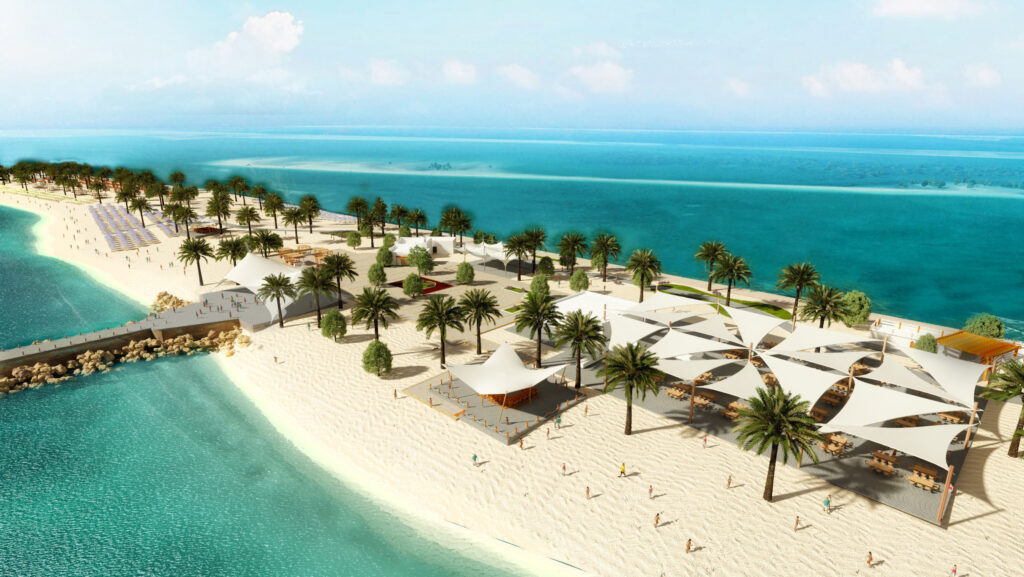The Flowering of Agriculture and Forestry in the United Arab Emirates
By: Habeeb Salloum/Arab America Contributing Writer

When visitors land at the Abu Dhabi International Airport, then drive to the heart of the city some 35 km (22 mi) away, they are overwhelmed by flowers, shrubs, date palms and other trees, lining both sides of the multi-lane thoroughfare. Not many travellers, seeing all this greenery know that this is a recent phenomenon. Half a century ago, not only Abu Dhabi, the United Arab Emirates’ capital, but the whole of the country consisted of towns built of adobe atop a landscape covered with sand – the home of Bedouin and camels.
Today, today, camel tracks have become six-lane highways, greenery dots the once barren sands and ancient dirt-trodden souks are now air-conditioned plazas. The towns with their clusters of dirt huts have been transformed into cities of luxurious villas and hotels, overshadowed by elegant apartments and skyscrapers. Where, in the past, migrating birds would fly over an inhospitable barren terrain, today they stop and breathe in a countryside dotted with dams, man-made oases and ever-expanding areas of farms.
In five decades, vegetation cover has grown approximately twentyfold. Farms and forests now cover over 4.5% of the land, and over 200 of the UAE islands have been partially greenified. There are 7,600 greenhouses and more than 30,000 farms spread throughout the country. Around the Liwa Oasis desert has been converted into cultivated land. Using a variety of ultra-modern and traditional irrigation techniques including that of the ancient aflaj system, orchards, cereal and vegetable fields, flowers and forests now flourish in every corner of the country.
With the proliferation of small farms, incentives given to farmers by the government and the adoption of modern agricultural techniques, tremendous progress has been made in the production of fruits and vegetables. UAE grown citrus fruits, avocados, grapes, guavas, strawberries, tomatoes and cut flowers are to be found as far away as the markets of Europe.
These small farms have become the basis for the country’s steadily increasing food production which has reached a million tons. A good number of food processing facilities have been set up and, besides the hundreds of artisan wells which have been drilled, 114 dams have been built and more are being planned or under construction. The aim is for the UAE to become self-sufficient in food production in the near future.
Tree planting and greenification are encouraged in every part of the country. Homeowners are urged to beautify their surroundings by government gifts of free plants and trees and state supported parks saturate cities like Abu Dhabi and Al Ain. Roads in many parts of the country are now edged by fields of trees and shrubs and islands like Sir Bani Yas, are now to some extent, covered with orchards and forest.

Much of this tree planting was due to the support of Sheikh Zayed bin Sultan al Nahyan, the late President of the UAE and one of the strongest environmentalists in the world. Under his guiding hand, the barren face of the desert was and continues to be transformed into a land of lush greenery. The horticulturalist Bernard Lavery, with 16 world records in horticulture, described Sheikh Zayed ‘as the man who tamed the desert’.
The massive agricultural development in the country has put 723,738 ha (1,787,633 ac) of once barren land under the plough – over 300,000 ha (741,000 ac) of these are man-made forests. The afforestation effort throughout the country, fueled by giant desalination networks and use of wastewater from urban and industrial projects, is truly remarkable.
In the Emirate of Abu Dhabi alone, some 130 million trees have been planted. Even more impressive are the UAE’s 22 million, mostly newly planted, palm trees which now represent 20% of all the palms in the world. The country is today one of the largest date producers and processors of this fruit in the world- a single factory processing annually 14,000 tons.
Another type of tree which is today proliferating the coastline of the UAE is the humble mangrove tree which can grow in saltwater. Its propagation is a pet project of Sheikh Zayed who was raised in the dry desert and appreciated a tree which grows in saltwater. New stretches of the UAE coast have been greenified by the salt tolerant mangrove. Today, these patches of greenery have become important habitats for various varieties of birds, fish, and invertebrates.
The most renowned of the afforestation projects in the Emirate of Abu Dhabi is on the island of Sir Bani Yas. Three and a half million trees and shrubs, 500,000 of these fruit trees, have been planted on the island. Many of these trees are forest species, some indigenous to the Emirates, and others introduced to test their capacity to adapt to the UAE’s arid climate.
Al Jurf, 100 km (61 mi) northeast of the city of Abu Dhabi, is another of the garden spots springing up in the UAE. In this area of transformed desert, massive planting has created a rich forest of more than a half million trees – mostly citrus fruit trees and palm.
The millions of newly planted trees, along with the countless gardens and parks are a wonderful example of fighting the desert and, at the same time, spreading greenery. Afforestation along with other aspects of the UAE’s agricultural revolution has greatly increased the greenification of the country. The extensive shade and evaporative cooling effect created by the man-made leaf canopy has helped moderate the climate by reducing local temperature by several degrees.
The famous movie star, the late Omar Sharif, who had visited the UAE in the early 1970s and had returned in 1996 to participate in a film being prepared by the leading British documentary director Morphet, was astonished at the country’s progress in greenification, saying, “I am totally dumbfounded by the greenery in the UAE”.
The UAE has been so successful in its greenification of the desert that neighbouring states often sought its advice on afforestation. Sheikh Zayed’s call, “Give me agriculture and I’ll warrant you a civilization”, seems to be echoing even outside the UAE borders. In Sheikh Zayed’s words, “They used to say, agriculture has no future, but with God’s blessing and our determination, we have succeeded in transforming the desert into a green land.”
Sheikh Zayed’s life-long dedication to improving the environment in the UAE and the Gulf region earned him the 1997 ‘Gulf Business Award for Environmental Action’ and the ‘Gold Panda Award’ – the top international conservation tribute. It was presented to him on 6 March 1997 by Britain’s Prince Philip, President of the World Wide Fund for Nature. A dedicated conservation supporter, not only in words but in deeds, as the UAE testifies, it is only fitting that Sheikh Zayed wase the first head of state to receive this award.









